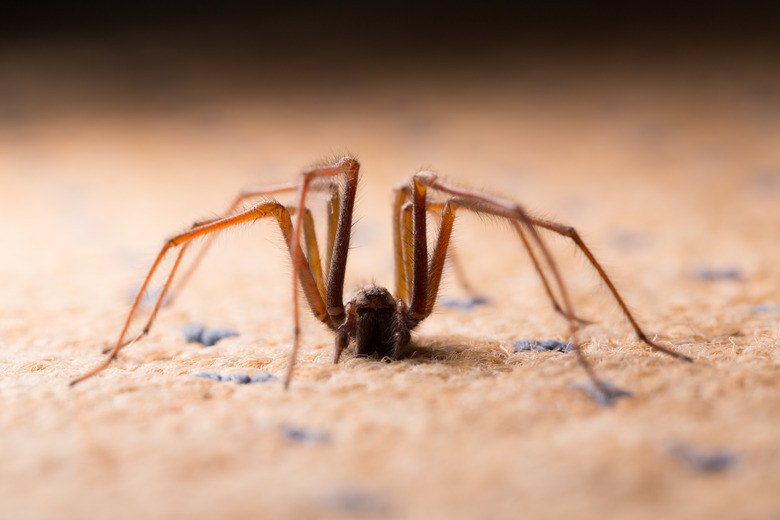How To Identify Spiders In Alberta
The Canadian province of Alberta is host to several fascinating species of spiders. Many nonvenomous spiders live in varying environments, including white goldenrod spiders, boreal cobweb spiders, jewel spiders and house spiders. Two venomous spiders, the western black widow and the hobo spider, give poisonous bites. Most spiders do not bite unless provoked, and they provide important pest control.
TL;DR (Too Long; Didn't Read)
Many spider species reside in the Canadian province of Alberta. Most are nonvenomous spiders including cobweb spiders, house spiders, wolf spiders and jumping spiders. Two spiders have historically been considered venomous, the hobo spider and the black widow spider, but the hobo spider may not be as dangerous as previously believed. The black widow spider gives a dangerous bite requiring medical attention.
Nonpoisonous Spiders
Nonpoisonous Spiders
The **European house spider,** commonly a victim of sliding into a tub or sink, is a medium-sized funnel web spider. Brown in color, the larger females reach almost 12 millimeters in size. They possess gray chevron patterns on their abdomens and banded legs. As their name suggests, these spiders were introduced from Europe. They build funnel-like webs, commonly in the corners of people's homes. The **giant house spider,** another introduced species, is larger without leg bands.
Wolf spiders do not construct webs. Effective hunters, these spiders grow over an inch long and are dark brown. They hunt for insects in open outdoor areas, but in colder seasons they often move inside people's homes.
Cellar spiders possess long legs, and as their name evokes, they enjoy the corners of cellars and basements. These spiders are often confused with daddy long-leg spiders, but these cellar spiders possess two body segments.
Fishing spiders live alongside waterfronts and shores. They resemble wolf spiders and consume minnows and insects.
Jumping spiders are an endearing form of spider with a tiny body and a large pair of front eyes. Their bodies look stocky and furry. These wee spiders stalk their prey and can leap several inches from their attached silk lines. Jumping spiders enjoy the sunlight.
Approximately 25 orb-weaving spider species reside in Alberta. One of them, the striking jewel spider, is quite large and boasts an image resembling a cat's face on its abdomen. The jewel spider constructs a typical orb web with spokelike lines and spirals. This orb-weaver prefers making webs around houses, often near light fixtures due to their attraction to prey insects. Three other orb-weavers of note include the banded Argiope spider, with silver and black stripes, the marbled spider and the shamrock spider.
One fascinating Alberta spider is a member of the crab spider family, the white goldenrod spider. These spiders can camouflage themselves to match their background. Their default color of white to yellow can morph over a couple of days to provide a shield from predators. A red mark is on their abdomens. These chameleons of the spider world enjoy perching on flowers to await potential prey.
A newly discovered crab spider species called Xysticus albertensis resides in northern Alberta.
Boreal cobweb spiders are nonpoisonous cobweb spiders with a reddish-brown abdomen and a pale "T" shape on the front. Although they sometimes are confused with black widows, they do not have black bodies with a red hourglass shape. Females reach approximately 7 millimeters in size. They can be found in the summer or fall. Boreal cobweb spiders prefer low vegetation and less-developed structures such as basements and outbuildings, as well as bridges and under rocks.
Poisonous Spiders
Poisonous Spiders
Hobo spiders contain venom but are not as dangerous as the black widow. There is currently some debate as to the extent of their danger. If bitten by a spider, collect the specimen and present it to a medical professional for identification.
The western black widow spider is conspicuously large and mostly black, save for the iconic red hourglass shape on its round abdomen. It is a cobweb spider generally found in the prairie regions of Alberta. Black widows thrive in abandoned animal warrens and shaded areas, unfinished basements, crawl spaces, garages and woodpiles. Wearing protective gloves in such areas can prevent a bite. Black widows tend to range in the southern part of Canada. Although shy, a black widow can give a poisonous bite that requires medical attention. If bitten, remain calm to prevent the rapid spread of the venom and seek a hospital or poison control center.
Cite This Article
MLA
Hermance, Dianne. "How To Identify Spiders In Alberta" sciencing.com, https://www.sciencing.com/identify-spiders-alberta-5113425/. 14 May 2018.
APA
Hermance, Dianne. (2018, May 14). How To Identify Spiders In Alberta. sciencing.com. Retrieved from https://www.sciencing.com/identify-spiders-alberta-5113425/
Chicago
Hermance, Dianne. How To Identify Spiders In Alberta last modified March 24, 2022. https://www.sciencing.com/identify-spiders-alberta-5113425/
